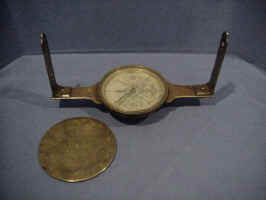|
By:
Dr. Richard and Robert Elgin
Elgin
Surveying & Engineering, Inc.
310
East 6th Street
Rolla,
Missouri 65401
Goldsmith
Chandlee was one of the most notable American clock and instrument makers of the
eighteenth and early nineteenth centuries. Born August 18, 1751 in
Nottingham, Maryland, Goldsmith was the oldest son of Quaker Clockmaker Benjamin
Chandlee, Jr. (1723-1791) and Mary Folwell Chandlee (died 1806). He was
named for his maternal grandfather, Goldsmith Folwell. Of Irish descent,
Goldsmith's grandfather was Benjamin Chandlee, Sr. (1685-died c.1745), known as
"the emigrant" who came to Philadelphia from Ireland in 1702.
Characterized as the "Six Quaker
Clockmakers" in a 1943 book by that title, the first of the six clockmakers
was Abel Cottey (1655-1711). He probably built the first clock in America.
A clock, marked "Abel Cottey, Philadelphia" is dated 1709. One
of his apprentices and Cottey's future son-in-law was Benjamin Chandlee, Sr.
("the emigrant"), the second Quaker clockmaker. Benjamin, Sr.
had six children, one of them being Benjamin, Jr., the third Quaker clockmaker.
Benjamin, Jr. had five children, three of which became clock and instrument
makers: Goldsmith, Ellis and Isaac Chandlee. These brothers are
considered the fourth, fifth and sixth Quaker clockmakers.
Goldsmith
apprenticed under his father in Nottingham, Maryland and by the time he was 24
he was an experienced craftsman. In 1775 he moved to Stephensburg (now
Stephens City), Virginia and then on to Winchester, Virginia in 1783.
There he built a brass foundry and a shop where he produced clocks, surveying
compasses, telescopes, money scales and other instruments of metal. His
business was located on the northwest corner of Cameron and Piccadilly
Streets where he owned several buildings and also resided. Besides making
clocks and compasses, he was active in many civic activities. He was a
member of the volunteer fire company, was a justice of the Corporation of
Winchester; sat on the Bench of Justice of Hastings Court of that city; and he
drafted deeds, mortgages and various legal papers and acted as executor of
estates. He was recognized as a leader of financial circles in northern
Virginia and established a counting house in which he bought an sold bills of
exchange, bonds, notes, soldiers certificates and military warrants. He
also dealt in land and owned large tracts of land in Pennsylvania, Virginia and
Kentucky.
Goldsmith married three times. He
first married in 1776 Ann White (died 1781). From this union came three
children, one being Benjamin III (1780-1822) who also was an instrument maker.
In 1784, Goldsmith married Hannah Yarnall (1750-1810). From this union
came four children, one being Goldsmith, Jr. (1788-1842). In 1811,
Goldsmith married Eunice Allen (1753-1822). They had no children.
 |
Goldsmith Chandlee must be counted as
one of the most notable American compass makers. His compasses are works
of art and were technically advanced. The compass faces show fine design,
craftsmanship, engraving and ornate decoration. Technically his compasses
were the most advanced of their day. He made both plain and vernier
compasses. All known Goldsmith Chandlee compasses but one have his
"L" and "T" table (for converting tenths of perches to links
and vice versa). All known Goldsmith Chandlee compasses have an outkeeper
and dial that converts outs to poles, the invention of which (or its application
to a compass) we can attribute to him. Some of his compasses
also have a counter where the surveyor could tally the miles chained. Most
of Chandlee's compasses have the name of the person for whom the compass was
made emblazoned on it. All known Goldsmith Chandlee compasses are marked
"Winchester" (Virginia). Probably the most notable person for
whom Chandlee made a compass (but not the most elaborate known Chandlee compass)
was Lawrence Washington, nephew of another surveyor, George Washington.
That compass is displayed at Mount Vernon.
Goldsmith has been described as a
small, sparse man with dark brown hair. He is said to have been fond of
company and "much given to entertaining." He died in Winchester
on March 4, 1821 and was buried in Center Meeting graveyard on the Valley Pike.
After his death his personal property was sold at auction. Sixty-six
items, mostly tools, compasses, clocks and compass parts were purchased by his
apprentice, George Graves (1792-1873). There are only a few known Graves
compasses, and they have the same features as the Goldsmith Chandlee compasses.
(Goldsmith's son, Benjamin III, also was an instrument maker. His known
compasses have the same features as his father's.) In the 1950's Goldsmith
Chandlee's body was removed to the Hopewell Centre Meeting graveyard north of
Winchester where his grave is today marked with a simple headstone marked
"G. Chandlee."
Collectors
and researchers always are curious as to how many compasses Goldsmith Chandlee
may have produced. There are no known Goldsmith Chandlee production
records and his compasses are not numbered. Through various sources, the
authors know of fourteen Goldsmith Chandlee compasses. He probably made
many more.
|
